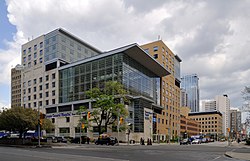| Toronto General Hospital | |
|---|---|
| University Health Network | |
 | |
 | |
| Geography | |
| Location | 200 Elizabeth Street Toronto, Ontario M5G 2C4 |
| Organisation | |
| Care system | Medicare |
| Type | Teaching |
| Affiliated university | University of Toronto Faculty of Medicine |
| Patron | Sophie, Duchess of Edinburgh |
| Services | |
| Emergency department | Yes |
| Beds | 471 |
| Speciality | Cardiology and Transplantation |
| History | |
| Opened | 1812 |
| Links | |
| Website | www |
The Toronto General Hospital (TGH) is a major teaching hospital in Toronto, Ontario, Canada, and the flagship campus of University Health Network (UHN). It is located in the Discovery District of Downtown Toronto along University Avenue's Hospital Row; it is directly north of The Hospital for Sick Children, across Gerrard Street West, and east of Princess Margaret Cancer Centre and Mount Sinai Hospital. The hospital serves as a teaching hospital for the University of Toronto Faculty of Medicine. In 2019, the hospital was ranked first for research in Canada by Research Infosource for the ninth consecutive year. [1]
Contents
- History
- Ajmera Transplant Centre
- Peter Munk Cardiac Centre
- Research
- See also
- References
- External links
The emergency department now treats 28,065 persons each year, while the hospital also houses the major transplantation service for Ontario, performing heart, lung, kidney, liver, pancreas, and small intestine, amongst others, for patients referred from all over Canada. The hospital is the largest organ transplant center in North America, performing 639 transplants in 2017. [2] The hospital is also renowned for cardiac and thoracic surgery. The world's first single and double lung transplants were performed at TGH in 1983 and 1986 and the world's first valve-sparing aortic root replacement was done by Tirone David at Toronto General Hospital in 1992. [3] The Lung Transplant program is currently the largest in the world, performing 167 lung transplants in 2017. [4] In 2015, surgeons performed the world's first triple organ transplant (lung, liver and pancreas) in 19 year old Reid Wylie at Toronto General Hospital. [5] TGH teaches resident physicians, nurses, and technicians; it also conducts research through the Toronto General Research Institute.
Currently, Sophie, Duchess of Edinburgh, as a member of the Canadian Royal Family, is patron of the hospital.

